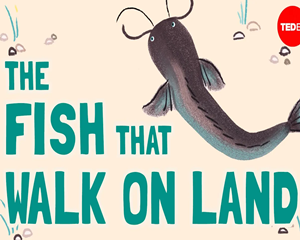This pond is the only home this fish has ever known. But lately, it's gotten crowded and food is scarce.
池塘是这条鱼所知唯一的家园,但最近,池塘变得拥挤,而且食物也变得匮乏了。
Luckily, it has an option many don't: as a walking catfish, it can dance its way out of the water and onto bigger and better things.
幸好它有很多鱼没有的选择:作为一条会走路的鲶鱼,它能一路舞动身体离开水面,去往更宽阔而更美好的地方。
However, it faces many challenges on its terrestrial journey:
但它的陆地之行面临众多的挑战:
it's now in danger of suffocating, drying up, suffering physical damage from rough terrain, and being hunted by land predators.
现在,它面临着窒息、身体干枯、粗糙地形对身体造成损伤,还可能被陆地掠食者猎杀。
We think of fish as completely aquatic animals.
我们以为鱼是纯粹的水生动物。
But the walking catfish is just one of hundreds of fish species that are actually amphibious, meaning that they possess adaptations that enable them to survive on land.
但两栖鱼类有几百种,蟾胡鲇只是其中之一,两栖指它们有适应陆地生存的能力。
Fish amphibiousness is a spectrum. At one end are species like the mosquitofish that'll only move on land when forced.
鱼类的两栖性是一个范围。一端是类似食蚊鱼这样的种类,只有在不得已的情况下它们才会到陆地上去。
And at the other end are species like mudskippers that nonchalantly hop around mudflats for days at a time.
而另一端则是像弹涂鱼这样的种类,能若无其事地在泥滩上一蹦就是好几天。
But why do fish make the exodus from water to land? And how do they cope with this drastic transition?
但是,鱼为何从水里游上陆地呢?它们又是如何应对这种剧变呢?
If temperatures get too high for the mangrove rivulus in the shallow tropical pools it inhabits, it'll flip itself onto a bank and cool off in the shade.
红树林鳉鱼栖息在热带浅滩中,如果那里温度太高的话,它就会跳上岸,在阴凉处凉快下来。
During the dry period, it can survive for two months out of the water by staying in moist environments.
干旱期来临,在没有水的情况下,它能在潮湿环境中存活两个月。
Meanwhile, the eel catfish makes its onshore voyage to satisfy its hearty craving for beetles. And for others, the terrestrial draw is more ritualistic.
与此同时,刚果河鳝胡鲶爬上岸只是为了吃最爱的甲虫。对其它鱼来说,登陆更有仪式感。
Every year under the cover of night, masses of California grunion flop their way onto sandy beaches,
每一年,在夜幕掩护下,大批加州滑银汉鱼登陆沙滩,
where females deposit thousands of eggs into the sand before re-entering the ocean.
雌鱼在沙滩上产卵数千枚后,又返回海洋。
Underwater, fish breathe with gills, which are feathery organs packed with blood vessels that absorb dissolved oxygen from the water.
在水里,鱼用鳃呼吸,鳃是一种布满血管的羽毛状器官,能吸收水里的氧气。
But in the open air, their gills collapse and are rendered useless, so amphibious fishes need other ways to breathe.
鱼一旦暴露在空气中,鳃就功能尽失而变得无用,所以两栖鱼需要其它呼吸方式。
The armored catfish's stomach is packed with blood vessels, so it can gulp down air and breathe through its stomach lining.
长丝髯甲鲶的胃里布满血管,因此它可以吞入空气,通过胃粘膜进行呼吸。

And lungfish, being related to the ancestors of all tetrapods, or four-limbed vertebrates, are equipped with true lungs.
肺鱼是所有四足动物或四足脊椎动物祖先的亲戚,它们有真正的肺。
They'll actually drown if they're kept underwater too long.
如果它们在水下待太久,反而会被淹死。
Fish have thin, permeable skin that allows for essential compounds to diffuse into and out of their bodies while they're underwater.
鱼的皮肤薄且有渗透性,当它们在水下时,必要的化合物能扩散进入、也能离开鱼的身体。
But this works against them on land as their bodily moisture diffuses into the air.
但在陆地上,这点对它们很不利,因为身体的水分会扩散到空气中。
To dodge dehydration, mudskippers roll in the mud like puppies.
为了避免脱水,弹涂鱼会像小狗一样在泥里打滚。
But the lungfish takes the cake: the rivers it inhabits disappear during dry seasons, so it buries itself in the earth and coats its body in a mucus cocoon.
但肺鱼却独辟蹊径:干旱季节,所在河流干涸,它会把自己埋进土里,用粘液茧把身体裹住。
It can survive like this for years until being resuscitated by the next big rainstorm.
像这样它可以存活数年,直到下次大暴雨才会复苏。
Amphibious fishes use powerful fins to move on land and clever tools to navigate as they go.
两栖鱼用强壮的鳍在陆上行走,并用它聪明的触须进行导航。
The Nopoli rock-climbing goby, no bigger than a few centimeters,
诺波利攀岩虾虎鱼仅几厘米长,
scales hundred-meter-tall Hawaiian waterfalls, inching its way up by alternately attaching the suction cups on its mouth and pelvic fins.
能攀爬数百米高的夏威夷瀑布,它会交替使用嘴和腹鳍上的吸盘,慢慢地往上爬。
To find water while on land, the mummichog, like most amphibious fishes, is on the lookout for reflective surfaces.
为了在陆地上找水,加拿大底鳉像多数两栖鱼一样,会寻找反光的表面。
Other species, like mosquitofish, exercise their inner ear to determine where they're oriented on a slope, relying on the probability that they'll find water by moving downhill.
其它种类的鱼,如食蚊鱼,用内耳判断该往斜坡的哪个方向走,这取决于它们下坡时找到水的可能性。
Our walking catfish, meanwhile, uses the taste buds that coat its body for navigation.
而蟾胡鲶则利用覆盖身体的味蕾来导航。
These taste buds are concentrated in its whiskers, which whip through the air, sensing compounds that signal the proximity and quality of nearby water -- and prey.
味蕾集中在它的胡须上,通过挥动胡须感知空中的化合物,来感知水域的距离和水质,以及有无猎物。
The walking catfish will shimmy towards attractive volatile amino acids while steering clear of foul waters emanating hydrogen sulfide.
蟾胡鲶会向着诱人的挥发性氨基酸而去,但会躲开散发硫化氢的污秽水域。
While amphibious fishes face a multitude of new challenges upon leaving the water, they've evolved ingenious ways to overcome them.
虽然两栖鱼在离开水时面临许多新挑战,但它们已进化出了巧妙的方法来克服这些挑战。
They're resilient in the face of droughts and floods and have access to new prey as well as a plan B if they need to escape competitive, polluted, or unhealthy environments.
面对干旱和洪水,它们适应力很强,还能找到新猎物,它们也有逃离竞争、污染或不健康环境的B计划。
While being a "fish out of water" is generally regarded as a bad thing, for these species, it offers an undisputed edge.
虽然“如鱼离水”往往会认为是件坏事,但对这些物种来说,离水却让它们有无可争辩的优势。


